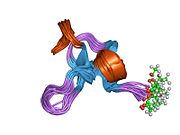LASP1
Protein-coding gene in the species Homo sapiens
| LASP1 | |||||||||||||||||||||||||||||||||||||||||||||||||||
|---|---|---|---|---|---|---|---|---|---|---|---|---|---|---|---|---|---|---|---|---|---|---|---|---|---|---|---|---|---|---|---|---|---|---|---|---|---|---|---|---|---|---|---|---|---|---|---|---|---|---|---|
 | |||||||||||||||||||||||||||||||||||||||||||||||||||
| |||||||||||||||||||||||||||||||||||||||||||||||||||
| Identifiers | |||||||||||||||||||||||||||||||||||||||||||||||||||
| Aliases | LASP1, MLN50, LIM and SH3 protein 1, LASP-1 | ||||||||||||||||||||||||||||||||||||||||||||||||||
| External IDs | OMIM: 602920; MGI: 109656; HomoloGene: 4480; GeneCards: LASP1; OMA:LASP1 - orthologs | ||||||||||||||||||||||||||||||||||||||||||||||||||
| |||||||||||||||||||||||||||||||||||||||||||||||||||
| |||||||||||||||||||||||||||||||||||||||||||||||||||
| |||||||||||||||||||||||||||||||||||||||||||||||||||
| |||||||||||||||||||||||||||||||||||||||||||||||||||
| |||||||||||||||||||||||||||||||||||||||||||||||||||
| Wikidata | |||||||||||||||||||||||||||||||||||||||||||||||||||
| |||||||||||||||||||||||||||||||||||||||||||||||||||
LIM and SH3 domain protein 1 is a protein that in humans is encoded by the LASP1 gene.[5][6]
This gene encodes a member of a LIM protein subfamily which is characterized by a LIM motif and a domain of Src homology region 3. This protein functions as an actin-binding protein and possibly in cytoskeletal organization.[6]
Interactions
LASP1 has been shown to interact with Zyxin.[7]
References
- ^ a b c GRCh38: Ensembl release 89: ENSG00000002834 – Ensembl, May 2017
- ^ a b c GRCm38: Ensembl release 89: ENSMUSG00000038366 – Ensembl, May 2017
- ^ "Human PubMed Reference:". National Center for Biotechnology Information, U.S. National Library of Medicine.
- ^ "Mouse PubMed Reference:". National Center for Biotechnology Information, U.S. National Library of Medicine.
- ^ Tomasetto C, Regnier C, Moog-Lutz C, Mattei MG, Chenard MP, Lidereau R, Basset P, Rio MC (Jan 1996). "Identification of four novel human genes amplified and overexpressed in breast carcinoma and localized to the q11-q21.3 region of chromosome 17". Genomics. 28 (3): 367–76. doi:10.1006/geno.1995.1163. PMID 7490069.
- ^ a b "Entrez Gene: LASP1 LIM and SH3 protein 1".
- ^ Li B, Zhuang Lei, Trueb Beat (May 2004). "Zyxin interacts with the SH3 domains of the cytoskeletal proteins LIM-nebulette and Lasp-1". J. Biol. Chem. 279 (19). United States: 20401–10. doi:10.1074/jbc.M310304200. ISSN 0021-9258. PMID 15004028.
Further reading
- Tomasetto C, Moog-Lutz C, Régnier CH, et al. (1995). "Lasp-1 (MLN 50) defines a new LIM protein subfamily characterized by the association of LIM and SH3 domains". FEBS Lett. 373 (3): 245–9. doi:10.1016/0014-5793(95)01040-L. PMID 7589475. S2CID 648563.
- Chew CS, Parente JA, Zhou C, et al. (1998). "Lasp-1 is a regulated phosphoprotein within the cAMP signaling pathway in the gastric parietal cell". Am. J. Physiol. 275 (1 Pt 1): C56–67. doi:10.1152/ajpcell.1998.275.1.C56. PMID 9688835.
- Schreiber V, Moog-Lutz C, Régnier CH, et al. (1999). "Lasp-1, a novel type of actin-binding protein accumulating in cell membrane extensions". Mol. Med. 4 (10): 675–87. doi:10.1007/BF03401929. PMC 2230251. PMID 9848085.
- Chew CS, Chen X, Parente JA, et al. (2003). "Lasp-1 binds to non-muscle F-actin in vitro and is localized within multiple sites of dynamic actin assembly in vivo". J. Cell Sci. 115 (Pt 24): 4787–99. doi:10.1242/jcs.00174. PMID 12432067. S2CID 18385678.
- Strausberg RL, Feingold EA, Grouse LH, et al. (2003). "Generation and initial analysis of more than 15,000 full-length human and mouse cDNA sequences". Proc. Natl. Acad. Sci. U.S.A. 99 (26): 16899–903. Bibcode:2002PNAS...9916899M. doi:10.1073/pnas.242603899. PMC 139241. PMID 12477932.
- Butt E, Gambaryan S, Göttfert N, et al. (2003). "Actin binding of human LIM and SH3 protein is regulated by cGMP- and cAMP-dependent protein kinase phosphorylation on serine 146". J. Biol. Chem. 278 (18): 15601–7. doi:10.1074/jbc.M209009200. PMID 12571245.
- Gevaert K, Goethals M, Martens L, et al. (2004). "Exploring proteomes and analyzing protein processing by mass spectrometric identification of sorted N-terminal peptides". Nat. Biotechnol. 21 (5): 566–9. doi:10.1038/nbt810. PMID 12665801. S2CID 23783563.
- Ota T, Suzuki Y, Nishikawa T, et al. (2004). "Complete sequencing and characterization of 21,243 full-length human cDNAs". Nat. Genet. 36 (1): 40–5. doi:10.1038/ng1285. PMID 14702039.
- Li B, Zhuang L, Trueb B (2004). "Zyxin interacts with the SH3 domains of the cytoskeletal proteins LIM-nebulette and Lasp-1". J. Biol. Chem. 279 (19): 20401–10. doi:10.1074/jbc.M310304200. PMID 15004028.
- Keicher C, Gambaryan S, Schulze E, et al. (2004). "Phosphorylation of mouse LASP-1 on threonine 156 by cAMP- and cGMP-dependent protein kinase". Biochem. Biophys. Res. Commun. 324 (1): 308–16. doi:10.1016/j.bbrc.2004.08.235. PMID 15465019.
- Gerhard DS, Wagner L, Feingold EA, et al. (2004). "The status, quality, and expansion of the NIH full-length cDNA project: the Mammalian Gene Collection (MGC)". Genome Res. 14 (10B): 2121–7. doi:10.1101/gr.2596504. PMC 528928. PMID 15489334.
- Tao WA, Wollscheid B, O'Brien R, et al. (2005). "Quantitative phosphoproteome analysis using a dendrimer conjugation chemistry and tandem mass spectrometry". Nat. Methods. 2 (8): 591–8. doi:10.1038/nmeth776. PMID 16094384. S2CID 20475874.
- Rual JF, Venkatesan K, Hao T, et al. (2005). "Towards a proteome-scale map of the human protein-protein interaction network". Nature. 437 (7062): 1173–8. Bibcode:2005Natur.437.1173R. doi:10.1038/nature04209. PMID 16189514. S2CID 4427026.
- Grunewald TG, Kammerer U, Schulze E, et al. (2006). "Silencing of LASP-1 influences zyxin localization, inhibits proliferation and reduces migration in breast cancer cells". Exp. Cell Res. 312 (7): 974–82. doi:10.1016/j.yexcr.2005.12.016. PMID 16430883.
- v
- t
- e
PDB gallery
-
 1zfo: AMINO-TERMINAL LIM-DOMAIN PEPTIDE OF LASP-1, NMR
1zfo: AMINO-TERMINAL LIM-DOMAIN PEPTIDE OF LASP-1, NMR
 | This article on a gene on human chromosome 17 is a stub. You can help Wikipedia by expanding it. |
- v
- t
- e
















